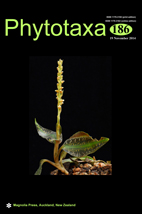Abstract
A detailed analysis of the type material of Vernonia oxyodonta clearly indicates that it is morphologically identical to Lessingianthus glabratus because it has glabrous leaves, pedunculate heads at the end of the inflorescence, outer phyllaries with acute apex and inner phyllaries with obtuse and mucronulate apex, and 30–40 florets per head. Consequently, all the specimens identified as V. oxyodonta are placed to a new species, L. pubescens. Also, V. pseudoincana is transferred to the genus Lessingianthus. This species belongs to the L. rubricaulis complex but can be distinguished from the remaining taxa of the group by its lanceolate leaves, grayish phyllaries, and habitat.

